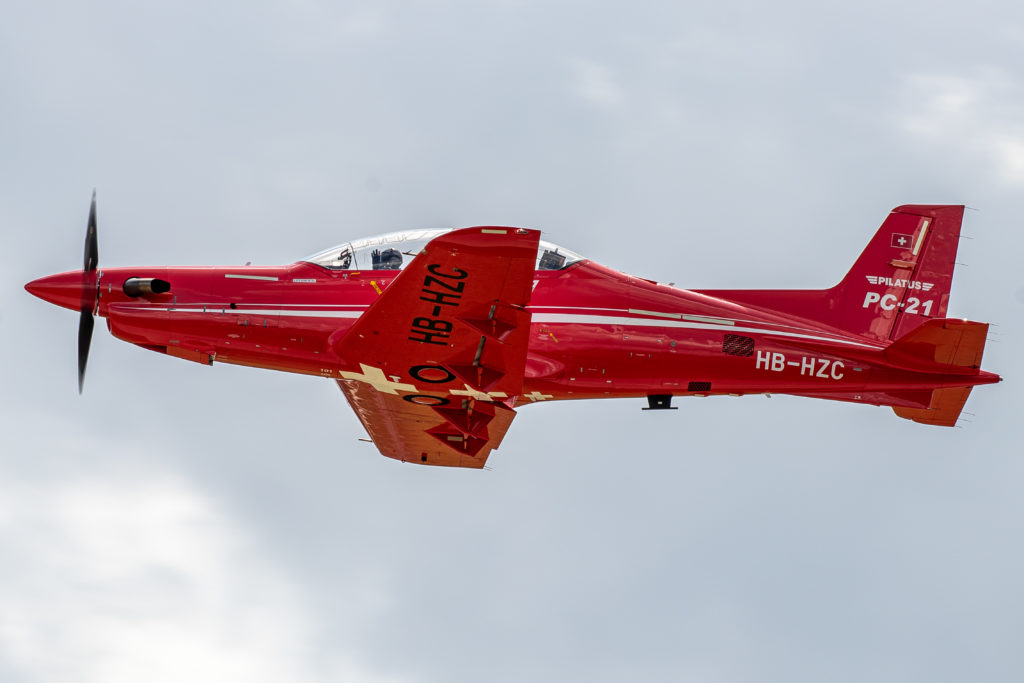Estimated reading time 5 minutes, 52 seconds.
Ask and they shall come.

When Pilatus Aircraft was invited to attend the Saskatchewan Airshow, the manufacturer dispatched its PC-21 military training aircraft on a 16-hour, 45-minute ferry flight from Stans, Switzerland, to 15 Wing Moose Jaw, Sask.
Making its debut on North American soil, the bright red single-engine turboprop trainer was a popular addition to the aerial performance lineup at the sold-out airshow, which returned to Moose Jaw on July 6-7 after a hiatus of 14 years.
“When the Saskatchewan Air Show reached out to the aviation industry for participation in our event, we were thrilled with the response from around the globe. We are certainly proud to have been selected by Pilatus as the North American debut for the PC-21,” said Maj Regan Wickett, air show director. “It was great having such variety of aircraft represented here. Getting up close to cutting edge technologies this weekend, it’s exciting to see how manufacturers are advancing the capabilities of military training aircraft.”
Pilatus – headquartered in Stans and best known in civilian aviation for its PC-12 single-engine turboprop and now the PC-24 twinjet – also has a long history of building military aircraft dating back to 1940.
Today, the manufacturer is touting its PC-21 “next generation trainer” as just one part of an integrated military pilot training network that also includes ground-based training and in-service support systems.
According to Pilatus, the PC-21 grows with a pilot’s capabilities, taking them from ab initio to advanced training and thereby eliminating the need for an elementary training platform while simultaneously preparing pilots for the transition to advanced fighter aircraft.
“With air force budgets under continuous pressure, the PC-21 provides a cost-effective and highly efficient training solution,” said André Zimmermann, Pilatus vice-president of Government Aviation. “On the PC-21, pilots destined to fly fighter aircraft do not need to transition to jets until much later than those flying conventional trainer aircraft, reducing training time. The combination of real flying and simulation is a significant advantage and cost saver over the lifetime of the training system.”

The PC-21’s visit to Moose Jaw comes at a time when the Royal Canadian Air Force (RCAF) is taking a hard look at revamping its aircrew training delivery.
Through the Future Aircrew Training Program (FAcT), the Canadian government has embarked on a competitive procurement program for the provision of future aircrew training, including classroom instruction, simulator and flight training. This includes not only pilots, but also air combat systems officer and airborne electronic sensor operator instructional programs.
On Dec. 10, 2018, five qualified suppliers were identified as having the ability to deliver such an integrated program to the RCAF. They include Airbus Defence and Space, Babcock Canada Inc., Leonardo Canada, Lockheed Martin Canada Inc., and SkyAlyne Canada Limited Partnership.
At this point, Zimmermann said Pilatus has not partnered with any of the FAcT approved suppliers, although the OEM remains in “close contact” and has had “preliminary discussions with potential partners.”
He added that the PC-21 is well suited to be Canada’s next military aircrew training platform, with its adaptability enabling it to replace the Grob 120A basic trainer as well as the more advanced CT-156 Harvard II turboprop and CT-155 Hawk advanced fighter lead-in trainer.
“The PC-21 is designed to meet the requirements for basic and advanced military pilot training and also to cover the Fighter Lead-In Training (FLIT) phase of the syllabus,” Zimmermann told Skies. “Therefore, the PC-21 would be an ideal aircraft to replace the current platforms. [It] is as benign and easy to fly for basic training students, as it is challenging and very productive for the advanced pilot preparing for the front line.”

The Canadian government expects to release a formal request for proposals (RFP) for the FAcT program in fiscal year 2019-2020, with an anticipated contract award in 2021. Bidders must adhere to Canada’s Industrial and Technological Benefits Policy (ITB), which requires the winning supplier to make investments in Canada equal to the value of the contract.
Zimmermann said Pilatus recognizes the ITB requirement for the FAcT program and added that the PC-21 would offer Canada a “specifically customized pilot training solution” that would allow the RCAF to achieve “significant savings compared to current legacy training systems.”
Pilatus has the capability to deliver aircraft in accordance with FAcT program timelines, he concluded.
— with files from Mike Luedey









Very beautiful airplane, I don’t think people at the airshow truly understood its capabilities and the technology of this aircraft. I hope the snow birds take note and use this for their training.